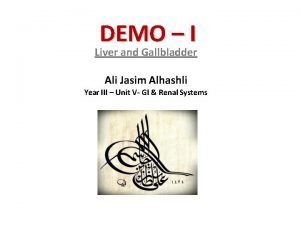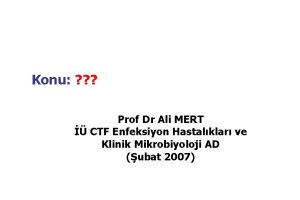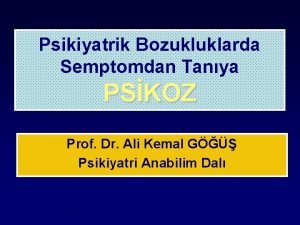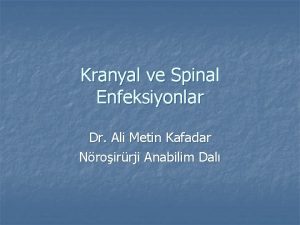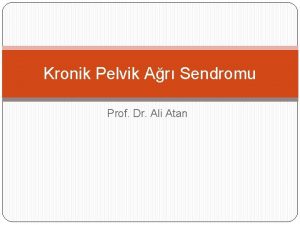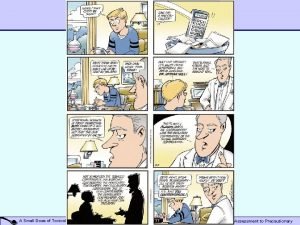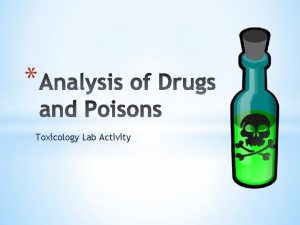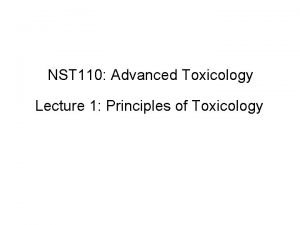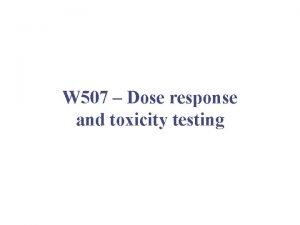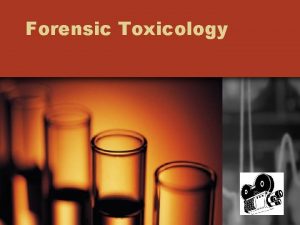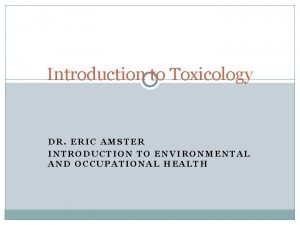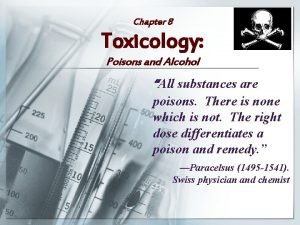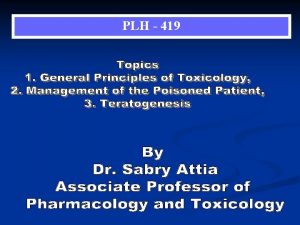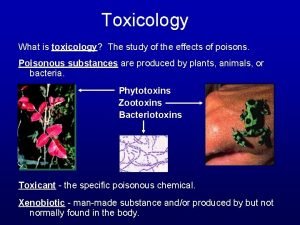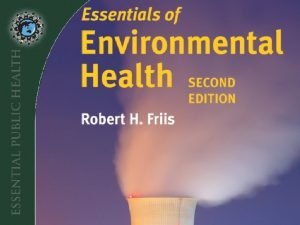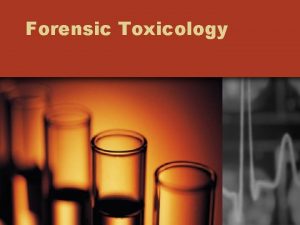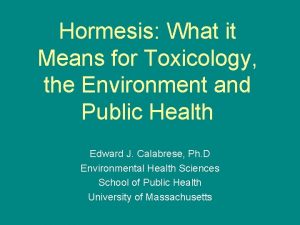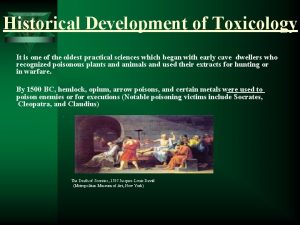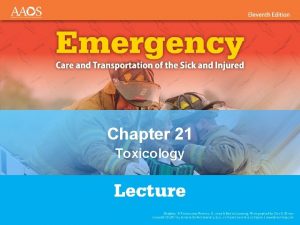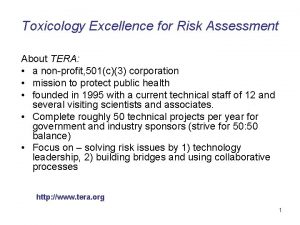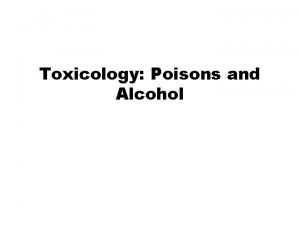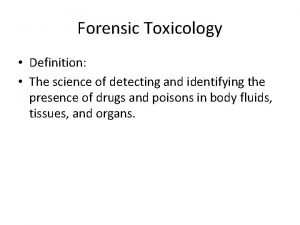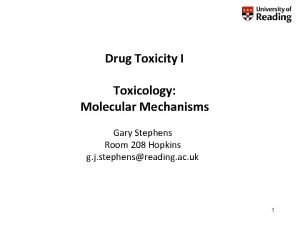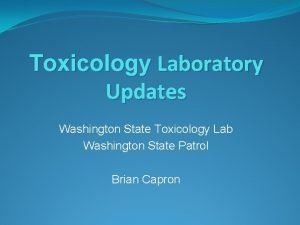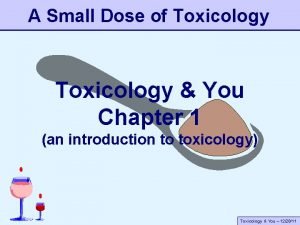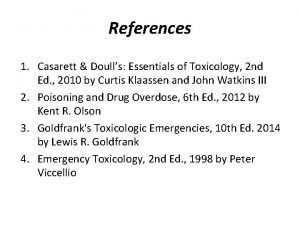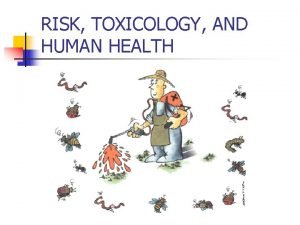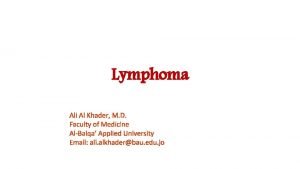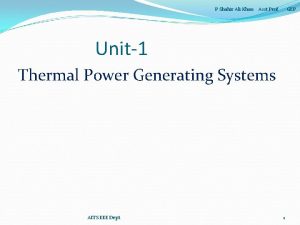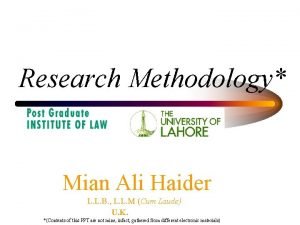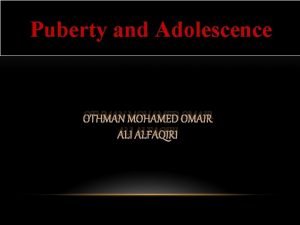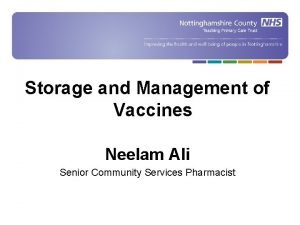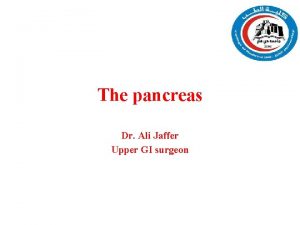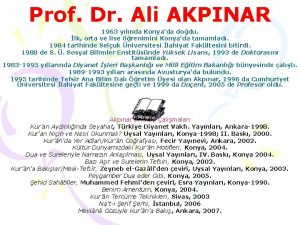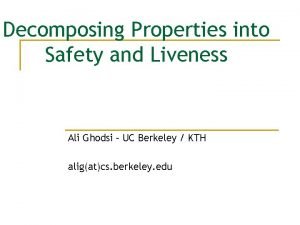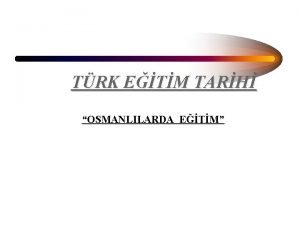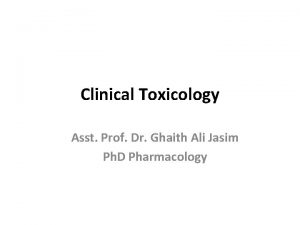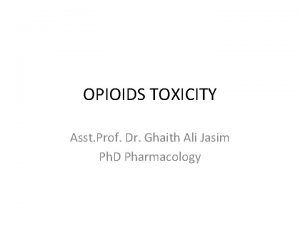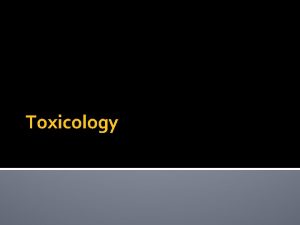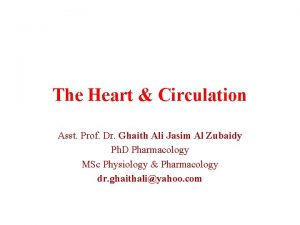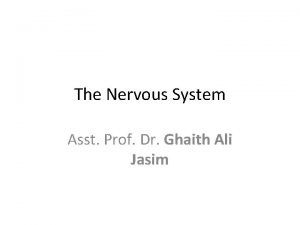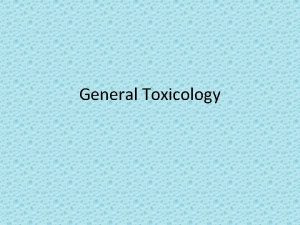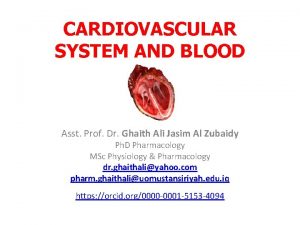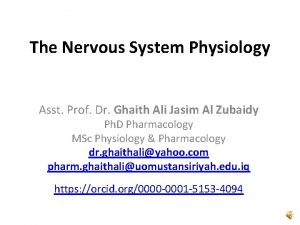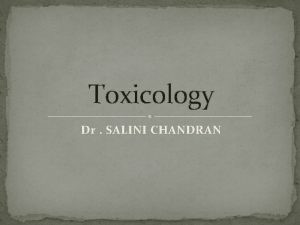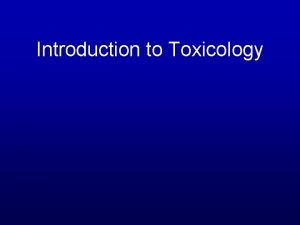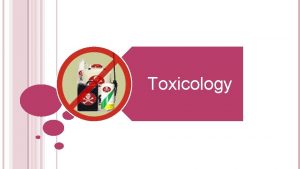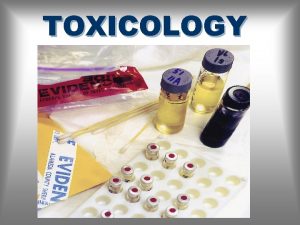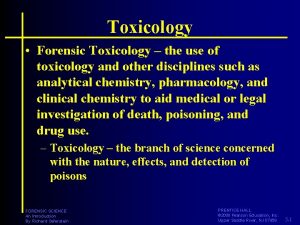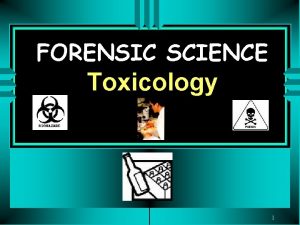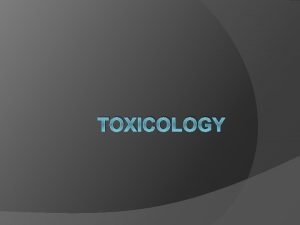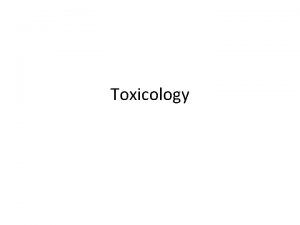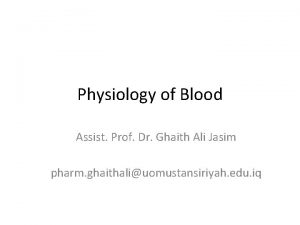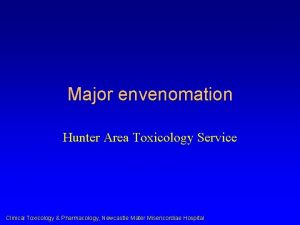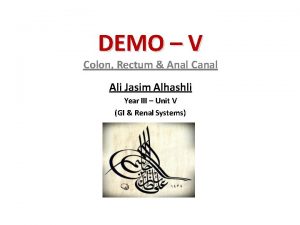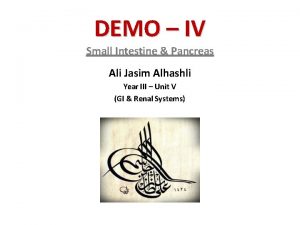Clinical Toxicology Asst Prof Dr Ghaith Ali Jasim

































































- Slides: 65

Clinical Toxicology Asst. Prof. Dr. Ghaith Ali Jasim Ph. D Pharmacology

Your Reference… Goldfrank’s Toxicologic Emergencies NINTH EDITION

• Toxicology is the science of poison and its effects in living organisms. There are several divisions of toxicology, one of which is clinical toxicology. • Clinical toxicology is the study of the toxic or adverse effects of agents, such as drugs and chemicals, in the body. Most of these agents are usually given to individuals in order to give relief for symptoms or to treat and prevent diseases.

• Clinical toxicology is focused on the diseases associated with short-term and long-term exposure to various toxic chemicals. It typically coincides with other sciences such as biochemistry, pharmacology, and pathology.

• Individuals who specialize in clinical toxicology are referred to as clinical toxicologists. • Their work focuses around the identification, diagnosis, and treatment of conditions resulting from exposure to harmful agents. • They usually study the toxic effects of various drugs in the body, and are also concerned with the treatment and prevention of drug toxicity in the population.

Several factors can influence the toxic effect of a certain substance. • One is the amount or dose of drug administered. Most chemicals, including water and oxygen, are often harmful to the body when taken in large doses. • Another factor is the route by which a person was exposed. A person can be exposed to various substances through ingestion, inhalation, and skin penetration. • The duration of exposure is also a vital factor in the effect of toxic substances in the body.

• There are high numbers of hospital admissions per year related to poisoning. The most common drugs that resulted in poisoning are paracetamol, salicylate, tricyclic antidepressant, and phenothiazine.

Clinical toxicology scope is the determination of factors that usually lead to drug overdoses and poisoning. • These factors include: • patient's incorrectly using prescribed drugs, • overprescribing of drugs, • and inattention to drug warnings. Drugs may also interact with other drugs the patient is also taking. Allergic reactions can also happen in predisposed individuals.

• Drug-related emergencies often require laboratory work to identify the drug that caused the poisoning. • Blood is usually extracted from the patient to test for the measurements of arterial blood gases, urea, electrolytes, and glucose, among many others. • A urine test is also frequently performed.

Medical Toxicology • The development of medical toxicology as a medical subspecialty and the important role of poison control centers began shortly after World War II.

• As new challenges and opportunities arise in the 21 century, two new toxicologic disciplines have emerged: toxicogenomics and nanotoxicology. • Toxicogenomics combines toxicology with genomics dealing with how genes and proteins respond to toxic substances. • Nanotoxicology refers to the toxicology of engineered tiny particles, usually smaller than 100 nm. Given the extremely small size of nanoparticles,

INITIAL EVALUATION OF THE PATIENT: VITAL SIGNS AND TOXIC SYNDROMES • pulse rate, respiratory rate, and temperature were incorporated into the bedside chart and called “vitalsigns”. • It was not until the early part of the 20 th century, that blood pressure determination also became routine. Additional components of the standard emergency assessment, such as oxygen saturation • By pulse oximetry, capillary blood glucose, and pain severity, are now also beginning to be considered vital signs.

Vital signs • In the practice of medical toxicology, vital signs play an important role beyond assessing and monitoring the overall status of a patient, as they frequently provide valuable physiologic clues to the toxicologic etiology and severity of an illness. • The vital signs also are a valuable parameter, which are used to assess and monitor a patient’s response to supportive treatment and antidotal therapy.

• the normal vital signs for various age groups. • Only a complete assessment of a patient can determine whether or not a particular vital sign is truly clinically normal.

• Many xenobiotics affect the autonomic nervous system, which affects the vital signs via the sympathetic pathway, the parasympathetic pathway, or both. • Careful attention to both the initial and repeated determinations of vital signs is of extreme importance in identifying a pattern of changes suggesting a particular xenobiotic or group of xenobiotics.

• The value of serial monitoring of the vital signs is demonstrated for example by the patient who presents with an anticholinergic over dose who is then given the antidote, physostigmine. In this situation, • it is important to recognize when tachycardia becomes bradycardia

• Similarly, consider the course of a patient who has opioid-induced bradypnea (a decreased rate of breathing) and then develops tachypnea (an increased rate of breathing) after the administration of the opioid antagonist naloxone. • The analysis becomes exceedingly complicated when that patient may have been exposed to two or more substances, such as an opioid combined with cocaine. In this situation, the effects of cocaine may be “unmasked” by the naloxone used to counteract the opioid, and the clinician must then be forced to differentiate naloxone induced opioid withdrawal from cocaine toxicity. • The assessment starts by analyzing diverse information, including vital signs, history, and physical examination.


Toxidromes from the words toxic syndromes to describe the groups of signs and symptoms that consistently result from particular toxins. These syndromes are usually best described by a combination of the vital signs and clinically apparent end-organ manifestations


• In some instances, an unexpected combination of findings may be particularly helpful in identifying a xenobiotic or a combination of xenobiotics. • For example, a dissociation between such typically paired changes as an increase in pulse with a decrease in blood pressure (cyclic antidepressants or phenothiazines), • or the presentation of a decrease in pulse with an increase in blood pressure (ergot alkaloids) may be extremely helpful in diagnosing a toxic etiology.

Blood pressure Xenobiotics cause hypotension by four major mechanisms: “ 4 D’s” - Decreased peripheral vascular resistance, - Decreased myocardial contractility, - Dysrhythmias, and - Depletion of intravascular volume.

• Many xenobiotics can initially cause orthostatic hypotension without marked supine hypotension, and any xenobiotic that affects autonomic control of the heart or peripheral capacitance vessels may lead to orthostatic hypotension.

• Hypertension from xenobiotics may be caused by: - CNS sympathetic over-activity, increased myocardial contractility or increased peripheral vascular resistance, or a combination of these. - Blood pressure and pulse rate may vary significantly as a result of changes in receptor responsiveness, degree of physical fitness, and degree of atherosclerosis.

Changing patterns of blood pressure often assist in the diagnostic evaluation: Ex. overdose with a monoamine oxidase inhibitor (MAOI) characteristically causes an initial normal blood pressure, to be followed by hypertension, which, in turn, may be followed abruptly by severe hypotension

Pulse rate • Pulse rate is the net result of a balance between sympathetic (adrenergic) and parasympathetic (muscarinic and nicotinic) tone, • many xenobiotics that exert therapeutic or toxic effects or cause pain syndromes, hyperthermia, or volume depletion also affect the pulse rate. • With respect to temperature, there is a direct correlation between pulse rate and temperature in that pulse rate increases approximately 8 beats/min for each 1. 8°F (1°C) elevation in temperature.

**The principle that no single vital sign abnormality can definitively establish a toxicologic diagnosis. In trying to differentiate between a sympathomimetic and anticholinergic toxic syndrome, it should be understood that although tachycardia commonly results from both sympathomimetic and anticholinergic xenobiotics: • When tachycardia is accompanied by diaphoresis (increase sweating) or increased bowel sounds, adrenergic toxicity is suggested, • But when tachycardia is accompanied by decreased sweating, absent bowel sounds, and urinary retention, anticholinergic toxicity is likely

Respiration • “normal” respiratory rates are 16 to 24 breaths/ min in adults with more rapid rates that are inversely related to age in children. • The term hyperventilation may mean tachypnea (an increase in ventilatory rate), hyperpnea (an increase in tidal volume), or both.

Hyperventilation may result from the direct effect of a CNS stimulant, such as the direct effect of salicylates, on the brainstem. However, • Salicylate poisoning characteristically produces hyperventilation by tachypnea, • but it also produces hyperpnea, with or without tachypnea.

• Pulmonary injury from any source, including aspiration of gastric contents, may lead to hypoxemia with a resultant tachypnea. • Later, tachypnea may change to bradypnea, hypopnea (shallow breathing), or both. • Bradypnea may occur when a CNS depressant acts on the brainstem. • A progression from fast to slow breathing may also occur in a patient exposed to increasing concentrations of cyanide or carbon monoxide

Temperature evaluation and control are critical. • The core temperature or deep internal temperature (T) is relatively stable (98. 6° ± 1. 08°F; 37° ± 0. 6°C) under normal physiologic circumstances. • Hypothermia (T <95°F; <35°C) • Hyperthermia (T >100. 4°F; >38°C)

• Life-threatening hyperthermia (T >106°F; >41. 1°C) from any cause may lead to extensive rhabdomyolysis, myoglobinuric renal failure, and direct liver and brain injury and must therefore be identified and corrected immediately.

• Hypothermia is probably less of an immediate threat to life than hyperthermia, but it requires rapid appreciation, accurate diagnosis, and skilled management

• Hypothermia impairs the metabolism of many xenobiotics, leading to unpredictable delayed toxicologic effects when the patient is warmed. • Many xenobiotics that lead to an alteration of metal status place patients at great risk for becoming hypothermic from exposure to cold climates.

PRINCIPLES OF MANAGING THE ACUTELY POISONED OR OVERDOSED PATIENT • Medical toxicologists and information specialists have used a clinical approach to poisoned or overdosed patients that emphasizes treating the patient rather than treating the poison. • The clinician must always be prepared to administer a specific antidote immediately in instances when nothing else will save a patient, all poisoned or overdosed patients will benefit from an organized, rapid clinical management plan.

• most medical toxicologists began to advocate a standardized approach to a comatose “coma” and possibly overdosed adult patient, typically by: - intravenous (IV) Administration of 50 m. L of DW, - 100 mg of thiamine and - 2 mg of naloxone - along with 100% oxygen at high flow rates. The rationale for this approach was to compensate for the previously idiosyncratic style of overdose management encountered in different healthcare settings.

• It was not unusual then to discover from a laboratory chemistry report more than 1 hour after a supposedly overdosed comatose patient, that the initial blood glucose was 30 or 40 mg/dl… a critical delay in the management of unsuspected and consequently untreated hypoglycemic coma.

• Today, however, with the widespread availability of accurate rapid bedside testing for capillary glucose and pulse oximetry for oxygen saturation, coupled with a much greater appreciation by all physicians of what needs to be done for each suspected overdose patient, clinicians can safely provide a more rational, individualized approach to determine the need for, and in some instances more precise amounts of, dextrose, thiamine, naloxone, and oxygen.

• The American Academy of Pediatricians (AAP) all but entirely abandoned its recommendations for the use of syrup of ipecac in the home. • The efficacy of orogastric lavage, even when indicated by the nature or type of ingestion, is limited by the amount of time elapsed since the ingestion. The value of whole-bowel irrigation (WBI) with polyethylene glycol electrolyte solution (PEG-ELS) appears to be much more specific and limited.

• Similarly, interventions to eliminate absorbed xenobiotics from the body are now much more narrowly defined or, in some cases, abandoned. • Multiple-dose activated charcoal (MDAC) is useful for select but not all xenobiotics. • Ion trapping in the urine is only beneficial, achievable, and relatively safe when the urine can be maximally alkalinized after a significant salicylate, phenobarbital, or chlorpropamide poisoning. • Finally, the roles of hemodialysis, hemoperfusion, and other extracorporeal techniques are now much more specifically defined.

MANAGING ACUTELY POISONED OR OVERDOSED PATIENTS • If all of the circumstances involving a poisoned patient is known. - The history may be incomplete, unreliable, or unobtainable; - multiple xenobiotics may be involved; and even when a xenobiotic etiology is identified, it may not be easy to determine whether the problem is an overdose, an allergic or a drug– drug interaction.

• It is sometimes difficult or impossible to differentiate between adverse effects of a correct dose of medication and the consequences of an unintentional overdose.

INITIAL MANAGEMENT OF PATIENTS WITH A SUSPECTED EXPOSURE *Similar to the management of any seriously compromised patient, the clinical approach to the patient potentially exposed to a xenobiotic begins with: • Recognition and treatment of life-threatening conditions, including airway compromise, breathing difficulties, and Circulatory problems such as hemodynamic instability and serious dysrhythmias.

• After the “ABCs” (airway, breathing, and circulation) have been addressed, the patient’s level of consciousness should be assessed because this helps determine the techniques to be used for Further management of the exposure.

• After the “ABCs” (airway, breathing, and circulation) have been addressed, the patient’s level of consciousness should be assessed because this helps determine the techniques to be used for Further management of the exposure.

MANAGEMENT OF PATIENTS WITH ALTERED MENTAL STATUS • Altered mental status (AMS) is defined as the deviation of a patient’s sensorium from normal. Although it is commonly construed as a depression in the patient’s level of consciousness, a patient with agitation, delirium, psychosis, and other deviations from normal is also considered to have an AMS

• After airway patency is established or secured, an initial bedside assessment should be made regarding the adequacy of breathing. If it is not possible to assess the depth and rate of ventilation, then at least the presence or absence of regular breathing should be determined.

• Any irregular or slow breathing pattern should be considered a possible sign of the incipient apnea, requiring ventilation with 100% oxygen by bag– valve–mask followed as soon as possible by endotracheal intubation and mechanical ventilation. • Endotracheal intubation may be indicated for some cases of coma resulting from a toxic exposure to ensure and maintain control of the airway and to enable safe performance of procedures to prevent GI absorption or eliminate previously absorbed xenobiotics.

• Pulse oximetry to determine Oxygen saturation has made arterial blood gas (ABG) analysis less of an immediate priority, pulse oximetry has not eliminated the importance of blood gas analysis entirely.

• In addition, carboxyhemoglobin determinations are now available by point of care testing and both carboxy-hemoglobin and methemoglobin may be determined on venous or arterial blood specimens. *In every patient with an AMS, a bedside rapid capillary glucose concentration should be obtained as soon as possible.

• The strength, rate, and regularity of the pulse should be evaluated, the blood pressure determined, and a rectal temperature obtained.

Electrocardiogram (ECG) and continuous rhythm monitoring are essential. Monitoring will alert the clinician dysrhythmias that are related to toxic exposures either directly or indirectly via hypoxemia or electrolyte imbalance. For example, ECG demonstrating QRS widening and a right axis deviation might indicate a life-threatening exposure to a cyclic antidepressant or another xenobiotic with sodium channel–blocking properties.

• In these cases, the physician can anticipate such serious sequelae as ventricular tachydysrhythmias, seizures, and cardiac arrest and consider Both the early use of specific treatment (antidotes). • such as IV sodium bicarbonate, and avoidance of medications, such as procainamide and Other class IA and IC antidysrhythmics, which could exacerbate the situation.

• Extremes of core body temperature must be addressed early in the evaluation and treatment of a comatose patient. Lifethreatening hyperthermia (temperature >105°F; >40. 5°C) is usually appreciated when the patient is touched (although the widespread use of gloves as part Of universal precautions has made this less apparent than previously).

• Most individuals with severe hyperthermia, regardless of the etiology, should have their temperatures immediately reduced to about 101. 5°F (38. 7°C) by sedation if they are agitated or displaying muscle rigidity and by ice water immersion.

• Hypothermia is probably easier to miss than hyperthermia, especially in northern regions during the winter months, when most arriving patients feel cold to the touch.

• Early recognition of hypothermia, helps to avoid administering avariety of medications that may be ineffective until the patient becomes relatively euthermic, which may cause iatrogenic toxicity as a result of a sudden response to xenobiotics previously administered.

• For a hypotensive patient with clear lungs and an unknown over dose, a fluid challenge with IV 0. 9% sodium chloride or lactated Ringer’s solution may be started. If the patient remains hypotensive or cannot tolerate fluids, a vasopressor or an inotropic agent may be indicated, and may more invasive monitoring.

• At the time that the IV catheter is inserted, blood samples for glucose, electrolytes, blood urea nitrogen (BUN), a complete blood count (CBC), and any indicated toxicologic analysis can be obtained. • A pregnancy test should be obtained in any woman with childbearing potential. • If the patient has an AMS, there may be a temptation to send blood and urine specimens to identify any central nervous system (CNS) depressants or so-called drugs of abuse along with other medications.

• Xenobiotic-related seizures may broadly be divided into three categories: (1) those that respond to standard anticonvulsant treatment (typically using a benzodiazepine); (2) those that either require specific antidotes to control seizure activity or that do not respond consistently to standard anticonvulsant treatment, such as isoniazid-induced seizures requiring pyridoxine administration;

• (3) those that may appear to respond to initial treatment with cessation of tonic–clonic activity but that leave the patient exposed to the underlying, unidentified toxin or to continued electrical seizure activity in the brain, as is the case with carbon monoxide poisoning and hypoglycemia.

Within the first 5 minutes of managing a patient with an AMS, 1. High-flow oxygen (8– 10 L/min) to treat a variety of xenobiotic induced hypoxic conditions 2. Hypertonic dextrose: 0. 5– 1. 0 g/kg of DW for an adult or a more dilute dextrose solution for a child; the dextrose is administered as an IV bolus to diagnose and treat or exclude hypoglycemia 3. Thiamine (100 mg IV for an adult; usually unnecessary for a child) to prevent or treat Wernicke encephalopathy. 4. Naloxone (0. 05 mg IV with upward titration) for an adult or child with opioid-induced respiratory compromise.

IDENTIFYING PATIENTS WITH NONTOXIC EXPOSURES The following general guidelines for considering an exposure nontoxic or minimally toxic will assist clinical decision making: 1. Identification of the product and its ingredients is possible. 2. None of the US Consumer Product Safety Commission “signal words” (CAUTION, WARNING, or DANGER) appear on the product label. 3. The history permits the route(s) of exposure to be determined.

4. The history permits a reliable approximation of the maximum quantity involved with the exposure. 5. Based on the available medical literature and clinical experience, the potential effects related to the exposure are expected to be at most benign and self-limited and do not require referral to a clinician. 6. The patient is asymptomatic or has developed the expected benign self-limited toxicity.

• To be continued…. .
 Porto systemic anastomosis
Porto systemic anastomosis Prof dr ali mert
Prof dr ali mert Avolisyon
Avolisyon Prof. dr. ali metin kafadar kimdir
Prof. dr. ali metin kafadar kimdir Dr ali hossain
Dr ali hossain Prof. dr. ali fuat güneri
Prof. dr. ali fuat güneri Ali atan
Ali atan Toxicology
Toxicology Forensic toxicology lab activity
Forensic toxicology lab activity Ld50 examples
Ld50 examples Importance of toxicology
Importance of toxicology Breath tests reflect alcohol concentration in which artery?
Breath tests reflect alcohol concentration in which artery? Toxicology
Toxicology Chapter 8 toxicology test
Chapter 8 toxicology test Chapter 8 toxicology poisons and alcohol
Chapter 8 toxicology poisons and alcohol Drug identification and toxicology
Drug identification and toxicology Toxicology defination
Toxicology defination Toxicology study
Toxicology study Toxicology definition
Toxicology definition Forensics toxicology definition
Forensics toxicology definition Hormesis toxicology
Hormesis toxicology Examples of toxicology
Examples of toxicology Toxicology management
Toxicology management Dumbels emt
Dumbels emt Which is more toxic
Which is more toxic Toxicology excellence for risk assessment
Toxicology excellence for risk assessment Toxicology effects
Toxicology effects Toxicology and applied pharmacology
Toxicology and applied pharmacology Definition of forensic toxicology
Definition of forensic toxicology Food safety and toxicology
Food safety and toxicology Toxicology
Toxicology Washington state toxicology lab
Washington state toxicology lab A small dose of toxicology
A small dose of toxicology Annual review of pharmacology and toxicology
Annual review of pharmacology and toxicology Forensic science history timeline
Forensic science history timeline Toxicology effects
Toxicology effects North carolina medical examiner toxicology
North carolina medical examiner toxicology Environmental toxicology definition
Environmental toxicology definition Forensic toxicology vocabulary
Forensic toxicology vocabulary Sure secure solutions
Sure secure solutions Sejarah perkembangan pseudocode
Sejarah perkembangan pseudocode Cse 301
Cse 301 Unsent messages to shiva
Unsent messages to shiva Ali al khader
Ali al khader Shahir ali
Shahir ali Ali ewing
Ali ewing Ali pasha hotel
Ali pasha hotel Ali taalimi
Ali taalimi Legal research methodology
Legal research methodology Dr omair ali
Dr omair ali Surah 14
Surah 14 Ali acar hukuk
Ali acar hukuk Ali nesin gençliği
Ali nesin gençliği Temperature record
Temperature record Naravne značilnosti pokrajine
Naravne značilnosti pokrajine Dr ali jaffer
Dr ali jaffer Tyber solihull sixth form
Tyber solihull sixth form Ali rezaei csulb
Ali rezaei csulb Koga ali česa
Koga ali česa Kıssaların en güzeli
Kıssaların en güzeli Ali ghodsi
Ali ghodsi Amasyalı hüseyinoğlu ali
Amasyalı hüseyinoğlu ali Sukur ali khan
Sukur ali khan Ali salvador
Ali salvador Hayali hayalbaz
Hayali hayalbaz Ali kaka
Ali kaka
